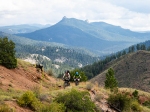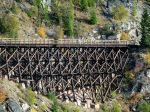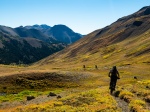The loud rattling took me by surprise. I was used to my gear jostling around as I descended bumpy dirt roads, but I’d never heard anything rattling in my spokes.
I was having a great ride down to the tiny outpost of Toche, flying through forests of wax palm trees, in a beautiful valley where farmers eked out a living harvesting the impossibly steep slopes.
Hearing the rattling, I brought my bike to a halt and looked back to see my backpack hanging off the back. Then I realized one of my panniers was missing…
The day had started off innocently enough with me leaving La Serrana hostel in Salenton at a casual 9 a.m. I was going back over the Cordillera Central, one of three branches of the Andes that run through Colombia, on my way to Ibague, where I hoped to connect with another bikepacker. I knew I had a long climb ahead of me but I was only planning on riding 50 kilometres that day so I was in no rush. I was told I’d see more wax palms on this route than in the famous Cocora Valley, and that there was a free hot springs I could camp at on the way. The route sounded perfect
I pedaled through Salento and then up the long climb to La Linea – the 3,400 metre pass that lay above. The road roughly followed an historic trail used first by natives, then by the Spanish conquistadors. The weather was nice, the road was in great shape and the grade was perfect. I spun away, counting down the kilometres and made it to the top in about four hours.
After a snack, I began the rollicking descent into the next valley. It wasn’t too steep or too windy so I could really open up at times, hitting the brakes only when necessary. I only stopped to take pictures of the steep mountainsides and the majestic wax palm trees that pointed erectly into the sky. One thing that constantly amazes me about Colombia is the terrain people farm and this valley may have been the most dramatic, with crops sowed on even the steepest slopes.
About eight kilometres into the descent I passed a guide who I’d talked to about my trip at the hostel the day before. He had tried to sell me on a trip to this valley, but I told him I’d be going there anyway on my bike. I was having too much fun to stop so I gave a quick wave and shouted “Hola!” without stopping. A few switchbacks later, disaster had struck – my right pannier, with all my camping gear in it was missing.
Initially I figured it must have just fallen off but there was no sign of it on the road. I envisioned it bouncing off the road, through the barb wire fencing, and down the steep side hill, but that seemed implausible. I stashed the rest of my bags at the side of the road and started riding up. There was one spot I thought it could be – next to a huge wax palm that I’d stopped to photography a few kilometres above. Maybe I jostled my pannier loose when I leaned my bike against the bank while taking pictures? What I couldn’t figure out was how I didn’t hear it falling off, nor did I notice a change in the handling of the bike.
I rode back up to the tree but there was no sign of the bag. I went back down and hiked down the side hill where I stopped, but still nothing. By this point it was getting late and my only hope was the guide had picked it up. Given the time, I decided it was best to ride into Toche and try to track down the guide over the phone. The rest of the descent was punctuated by a few short steep climbs and a really steep and rough finish.
 Toche is a two intersection town trapped in a steep valley where the only way out is up, but it did have a barebones hostel to stay at. I explained my predicament to the owner and she offered to help and try to contact the guide. Except she didn’t have cell reception at the moment.
Toche is a two intersection town trapped in a steep valley where the only way out is up, but it did have a barebones hostel to stay at. I explained my predicament to the owner and she offered to help and try to contact the guide. Except she didn’t have cell reception at the moment.
In the middle of nowhere Colombia, with my camping gear missing, unable to properly speak the language, and no real clue what to do, I lost it. I had a complete emotional breakdown and started cursing myself for being so stupid and not paying attention to my bike. I questioned what I was doing, riding down these remote roads solo in a foreign country where I barely speak the language. I struggled to regain my emotions as I rinsed off in a cold shower, then went to cook dinner. I made a plan in my mind to hire someone to drive me up the road to look for the bag. If that didn’t work, I’d bike back up. I had visions of taking a bus to Bogota to replace my gear.
After my breakdown, my fortune turned. The woman who ran the hostel was able to track down the guide and confirmed he had my pannier. I was pissed he didn’t just leave it for me to find I don’t know but I was even more grateful it was in a safe spot. The next morning I was up early to take a combination of jeep, bus, and minibus back to Salento.
It was a five hour journey and when I reached Salento I found out the guide had a tour booked that was going through Toche and he was about to leave. I could have avoided the trip, but on the plus side I was able to get a ride back to my bike the fast way. I took an expensive taxi up the road to the guide’s home, where I was reunited with my pannier and all my camping gear inside. I broke out into a huge smile and did a little leap of joy. I jumped in his jeep and we rode back drove the same road I had ridden the day before.
 I returned to Toche at around 3:30 and enjoyed a standard Colombian lunch – my first proper food all day. I then packed up my gear quickly, determined to get to those hot springs and not spend another night in that dingy hostel. They were 10 steep kilometres away and I made it right as the final light left the sky. The hot springs were lukewarm, but they felt so good after a stressful day and a half. I pitched my tent under an unused shelter, and that night it poured rain, but I stayed dry. Twenty-four hours after I’d hit bottom, I was basking on a high, grateful for all the help I’d received to put my trip back on track.
I returned to Toche at around 3:30 and enjoyed a standard Colombian lunch – my first proper food all day. I then packed up my gear quickly, determined to get to those hot springs and not spend another night in that dingy hostel. They were 10 steep kilometres away and I made it right as the final light left the sky. The hot springs were lukewarm, but they felt so good after a stressful day and a half. I pitched my tent under an unused shelter, and that night it poured rain, but I stayed dry. Twenty-four hours after I’d hit bottom, I was basking on a high, grateful for all the help I’d received to put my trip back on track.
 The next day I rode the 50 kilometers to Ibague. It started off misty and drizzly and I enjoyed a greasy descent before climbing back up to make up all the elevation I had just lost. Then it was mostly downhill to the main highway, the road ending through passing through a series of tunnels a few kilometres before Ibague.
The next day I rode the 50 kilometers to Ibague. It started off misty and drizzly and I enjoyed a greasy descent before climbing back up to make up all the elevation I had just lost. Then it was mostly downhill to the main highway, the road ending through passing through a series of tunnels a few kilometres before Ibague.
Ibague felt like a typical mid-sized Colombian city. It wasn’t all that attractive but it did have a bustling downtown and a big market that I took the opportunity to explore. I took my chances by going to a Chinese restaurant for lunch (it was really bad) but did succeed in finding some 96 per cent alcohol for my cooking stove. I stayed at the only hostel in town where I met another bike tourer, Nick, who was waiting out the rainy season by teaching English. We traded stories and talked bikes and future plans. I got a ticket on a night bus to Pitalito so I could go to San Augustin to see a bunch of ancient rock carvings and speed up my journey south. It would mean missing out on the Tatacoa Desert, but I would also avoid several days of highway riding.
The GPS track for this route can be found here: https://ridewithgps.com/trips/20079538

















Leave a comment